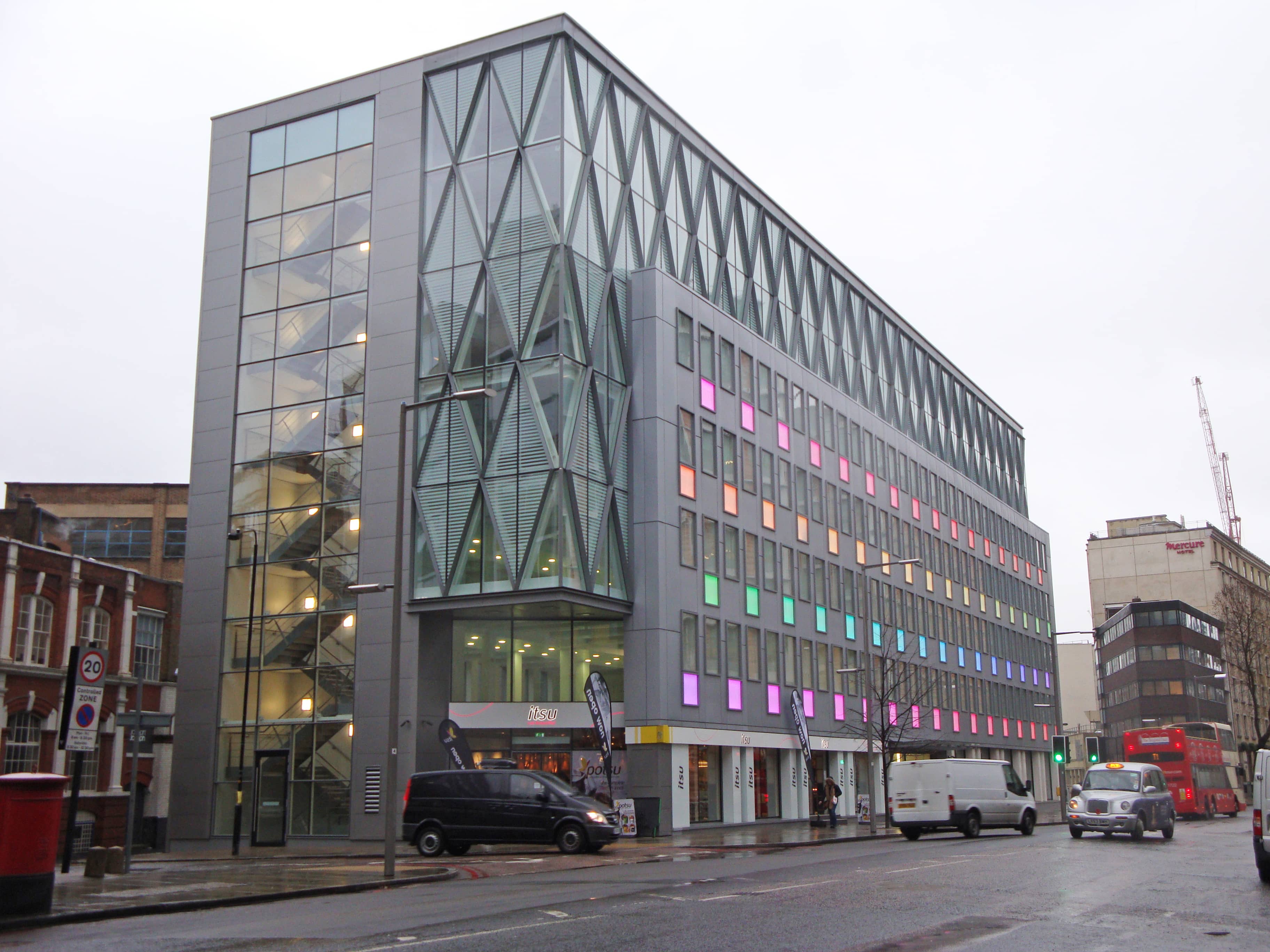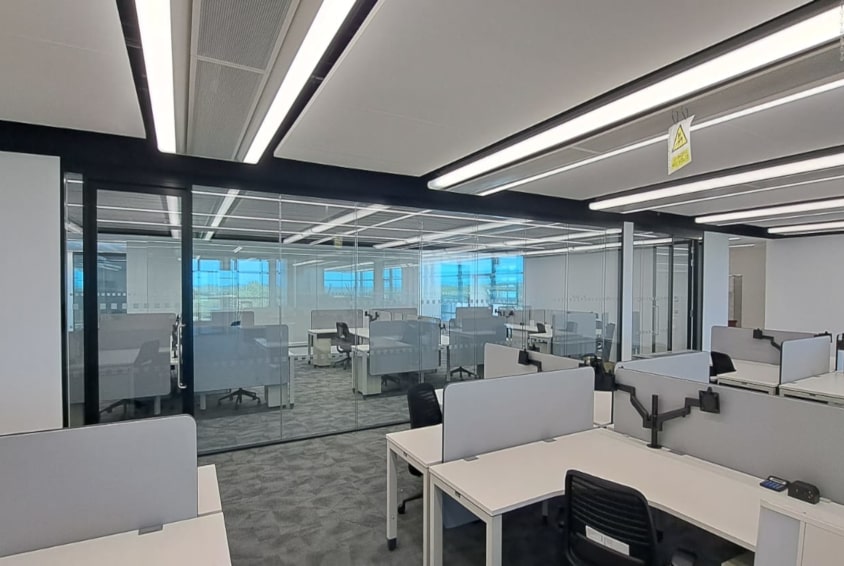Reduced Carbon with Chilled Beam Systems

Chilled Beam systems as a building cooling and heating (if required) solution have been embraced for not only their design flexibility when it comes to architectural aesthetics but also their environmental and comfort benefits.
First tier Consulting Engineers ‘Hoare Lea’ have just launched their HVAC Performance Assessment Tool for ‘Whole Life Carbon’, as featured in the CIBSE Journal this month.
This early-stage selection tool, which calculates the whole life carbon (WLC) for HVAC systems, has provided new data specifically with regards to embodied carbon, which shows the significant advantages for buildings using Active Chilled Beam (ACB) units alongside Air Source Heat Pumps (ASHP) as opposed to other HVAC systems.

Chilled Beam systems, particularly when combined with air source heat pumps (ASHP), represent a compelling option for reducing carbon emissions in buildings. These systems are increasingly popular due to their energy efficiency, low operational carbon emissions, and flexibility in design to accommodate other building services such as lighting, PA/VA and sprinkler systems.
With the drive toward net-zero buildings both Active and Passive Chilled Beam system stands out as an optimal HVAC technology that aligns with both sustainability goals and the high demands of good thermal comfort, long life expectancy, low energy consumption, with the ability to handle large heat gains/ heat losses. Chilled Beams have been in the UK for over 25 years and are used by owner occupied and government buildings as they are responsible for the energy and maintenance costs associated with the HVAC systems, Chilled Beam technology is on the whole the optimum HVAC solution on the market.
How Chilled Beam Systems Work
Chilled Beam systems provide an innovative HVAC solution to heating and cooling optimising indoor air comfort while minimising energy consumption. These are a water driven cooling and heating apparatus that can provide a highly efficient transportation of heat energy out of (Cooling) or into (Heating) the building without the use of refrigerants. Water has a coefficient of heat transfer four times greater than that of air to transfer heat energy.

Passive Chilled Beams are a static convective cooling device that are installed either exposed or concealed behind a perforated ceiling, these units provide cooling using natural convection where the spatial warm rises due to natural buoyancy, at high level the warm air is then cooled by the Passive Chilled Beams colder surfaces, as the cooler air is more dense than the warmer surrounding air it then naturally descends back into the occupied space providing cooling with minimal air movement and no risk of draughts.
In addition to convective cooling, Frenger’s X-Wing units also provide 40% of the heat exchange via radiant absorption, allowing 40% higher levels of cooling without any extra air movement and hence still achieving excellent occupant comfort and air speeds not to exceed 0.25 m/s even at 300w/m. X-Wing can also be used for heating via switch over valve from cooling to heating.

Active Chilled Beam’s function utilising the fresh outdoor air supplied via a central plant air handling unit (AHU), the fresh air is delivered into the space via air supply nozzles positioned along the length of the chilled beam, as the fresh air is discharged it provides a negative pressure within the active chilled beam, this negative pressure induces room air through the Chilled Beams heat exchanger coil, the conditioned air then mixes with the fresh air before being discharged horizontally into the space using the Coanda effect, so ensuring high thermal comfort levels.
As both Active and Passive Chilled Beams provide cooling using elevated chilled water temperatures above spatial dew point, typically 14° or greater flow temperature, with active chilled beams also able to provide heating with low temperatures below 50°C, it makes them the ideal solution to use with Air Source Heat Pumps (ASHP).
Carbon Efficiency of Chilled Beam Systems
In the context of whole life carbon (WLC), Chilled Beam systems offer significant reductions in both operational and embodied carbon emissions compared to other HVAC systems. According to the data from the CIBSE Journal, the Active Chilled Beam system demonstrates a 15% reduction in WLC compared to air source heat pump-fan coil unit (ASHP-FCU) and hybrid variable refrigerant flow (HVRF) systems. It also achieves a 47% reduction compared to traditional variable refrigerant flow (VRF) systems.

This reduction is attributed to the efficient energy use inherent in the system's design and its reliance on chilled water for cooling, which has a lower carbon footprint than refrigerant-based systems. Additionally, because the system uses fresh air handling units, it provides enhanced indoor air quality, another key factor in building sustainability.
Embodied Carbon Considerations
Embodied carbon refers to the greenhouse gas emissions associated with the manufacturing, transportation, and disposal of building materials. In chilled beam systems, much of the embodied carbon comes from the materials used in the water piping and the air handling units. However, when compared to VRF systems that rely heavily on refrigerants like R410a or R32, which have high global warming potential (GWP), Chilled Beams present a more sustainable choice. By using chilled water rather than high-GWP refrigerants, the system minimises its overall environmental impact.

Energy Efficiency and Whole Life Carbon
Energy consumption is another crucial aspect of a building’s carbon footprint. The active chilled beam system combined with an ASHP performs better than many other HVAC systems in terms of energy efficiency. In the case study outlined by the CIBSE Journal, Chilled Beam systems demonstrated energy consumption figures lower than that of VRF and HVRF systems, which are traditionally more reliant on high-energy refrigerant cycles.

The energy consumption for Chilled Beam systems in the study was approximately 44 kWh/m², and its whole life carbon footprint was around 175 kgCO₂e/m². This makes it a strong contender for projects aiming to minimize energy use and carbon emissions, particularly in office buildings and large-scale commercial developments.
You can read more about Hoare Leas’ HVAC Selection tool in the CIBSE Journal here:
Conclusion
As the demand for sustainable building solutions grows, both Active and Passive Chilled Beam systems represent a promising option for developers and engineers aiming to reduce both operational and embodied carbon in HVAC systems. Their efficient design, lower reliance on harmful refrigerants, and superior energy performance make them a pivotal technology in the journey toward net-zero buildings. For projects focused on sustainability, the Chilled Beam system offers not only immediate benefits in energy savings but also long-term reductions in carbon emissions throughout the building’s life cycle.
How Frenger can help
Frenger are proud to have supplied their X-Wing units to Australia’s first ever Net-Zero Precinct at Sydney Harbour “Barangaroo” and have decades of knowledge of climate testing, having 3x climate test laboratories, 2x photometric lighting laboratories and one acoustic laboratory at their UK headquaters and technical facility at Pride Park, Derbyshire.

Benefits of Chilled Beam Systems:
- Chilled Beam technology can provide energy savings of approximately 22% (according to an EDSL TAS Energy Study).
- Free-hanging Chilled Beams allow for dematerialisation by removing the need for suspended ceiling systems (removing suspended ceiling systems – 14% savings in embodied carbon) and also creates a visually larger volumetric space.
- Chilled Beams operate on clean potable water (i.e. no refrigerants) this allows them to provide a much safer environment for occupants as there is no risk of refrigerant leakage within the building envelope, and vastly reduced carbon (Co2) usage.
- Good indoor air quality (IAQ), as Active Chilled Beams don't recirculate dirty air from ceiling voids and/or other areas of the building. All recirculated air is kept room side and local to the room space.
- Control humidity levels: It is important to control the indoor space Relative Humidity (RH) levels. 50% RH is an ideal humidity level and is associated with Chilled Beam systems as Chilled Beams operate with 'dry coil'. Other terminal unit systems operate with 'wet coil', constantly dehumidifying the space and treating low humidity. Low humidity such as 30% RH can increase the spread of airborne viruses such as COVID-19 and cause dry mouth/ sore throats. Chilled Beam Systems operate above dew point (dry coil) and so do not provide latent cooling (dehumidification) within the room space, latent cooling (dehumidification) is at the AHU (air handler unit). This means Chilled Beams cannot over dehumidify, unlike other terminal systems that function below dew point (wet coil).
- Chilled beams have no moving parts hence are very low maintenance and have a long life expectancy (greater than 25 years).
- Lower Operational Costs - For example, Active Chilled Beams can offer an energy cost savings of 20-25% (according to the UK Government's Department for Business, Energy & Industrial Strategy) compared to FCU (Fan Coil Units) or variable air volume (VAV) systems.
- Multi-Service Chilled Beams (MSCBs) allow for the integration of LED lighting, alongside accommodating other building services in single ‘plug and play’ units, that are 100% prefabricated off-site reducing the overall site construction programme, saving on - site co-ordination issues for many other building services.
- Chilled Beams naturally work with the readily available temperatures associated with Heat Pumps.
To find out more about Frenger's carbon efficient chilled beam systems, click the button below.
Alternatively, you can contact their UK Head Office to inquire about their product range on +44(0)1332 295 678 or sales@frenger.co.uk.




